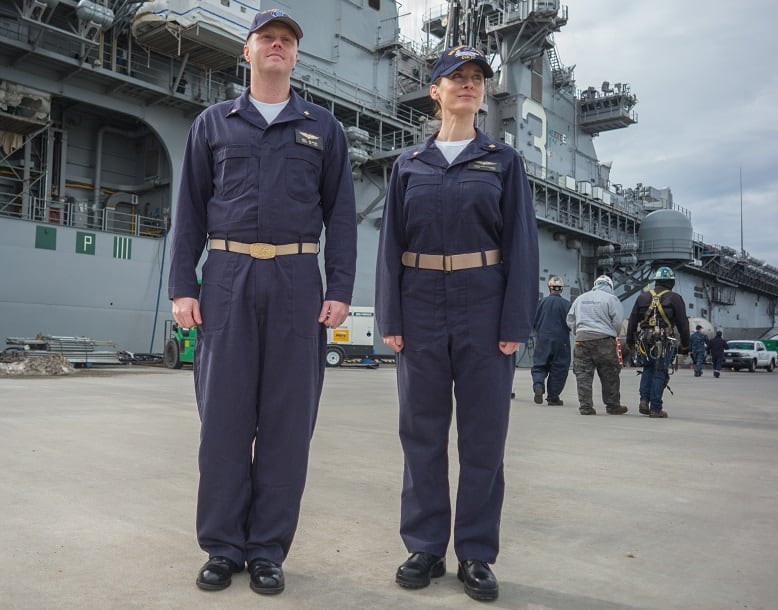The Navy is developing a new two-piece, command-issued uniform that could bring khakis back to sea for the first time in years.
Hundreds of sailors will be participating in the initial round of wear tests for the uniform that Navy officials are calling the “Maritime Two-Piece Fire-Retardant Variant.”
The new uniforms could eventually replace the Navy’s coveralls as an operational uniform, both on ship and at shore-based operational commands for some, but not all sailors.
The set of getups will include a khaki variant for chiefs and officers.
For sailors E-6 and below, the Navy will test two variants. One set will feature dark blue shirt and pants, colors similar to the existing coveralls, and the other will feature a light blue shirt and dark blue pants, a contrasting color scheme reminiscent of the traditional dungaree uniform.
RELATED

The design comes after sailors in focus groups voiced overwhelming interest in a two-piece similar to the Coast Guard’s operational dress uniform.
“This was sailor driven and came out of focus groups in Norfolk and San Diego, encompassing roughly 250 sailors from all communities,” said Capt. Mark Runstrom, director of Fleet Supply Operations and Services at U.S. Fleet Forces Command.
Runstrom said 84 percent of those sailors said the Navy should pursue a two-piece fire-retardant uniform.
The focus groups also found that sailors want a uniform they can wear while commuting to and from work, which Navy officials say will likely be permitted with the new two-piece.
A return to an all-khaki, at-sea working uniform is bound to be popular with officers and the chiefs mess, who complained loudly in 2010 when the Navy put all ranks in the Navy Working Uniforms, or NWUs.
The E-6 and below sailors from the focus groups generally preferred the completely dark blue version rather than the light-dark contrast, Runstrom said.
“There are pros and cons to each approach so we’re going to test both,” he said.
“There was a strong desire for an untucked shirt, comparable to the NWU, but we really wanted to go for a more professional looking cut to the uniform that doesn’t hang as long as the NWU and not as baggy,” Runstrom said.
It remains unclear whether the new two-piece will eventually become seabag issue.
“Right now, we are working on developing organizational clothing to be issued by operational commands,” Runstrom said. “If this is eventually adopted, any seabag decisions will be up to Navy leaders to make,” Runstrom said.
The use of the new uniform will extend to a limited degree into the aviation community. Aviators and aircrew already have fire-retardant flight suits, but maintainers and others would likely wear the new two-piece.
In some situations, the two-piece could replace the NWUs entirely. But Runstrom says what’s being developed is organizational clothing, which is clothing issued by the Navy for special purposes and not seabag issue uniforms.
“We want the uniform to be worn at operational commands ashore, such as regional maintenance centers, shipyards, squadrons and hangers — places where you would typically wear the NWUs today, you would wear the two-piece fire-retardant variant,” said Runstrom.
The three-month wear test will likely begin in March and will involve roughly 350 participants across eight geographic regions and 28 commands. It is expected to last for three to four months.
Each tester will get four nonidentical uniforms that will feature a slightly different configuration of design elements and pocket layouts, allowing officials to gather plenty data to develop a single design should the Navy decide to implement the uniform fleet-wide.
Chiefs and officers will test four sets of khakis, while each E-6 and below will get two sets of dark blue and two sets of the light blue shirt, dark blue pant version.
Rundstrom said the two-piece outfit is not going to replace the coverall in the Navy inventory.
“There’s always going to be a place in the Navy for coveralls,” he said. “We aren’t looking to replace them, but what we want is something that is more versatile for the majority of sailors in our operational commands, and a two-piece uniform, if ultimately adopted, would provide that.”
Mark D. Faram is a former reporter for Navy Times. He was a senior writer covering personnel, cultural and historical issues. A nine-year active duty Navy veteran, Faram served from 1978 to 1987 as a Navy Diver and photographer.




